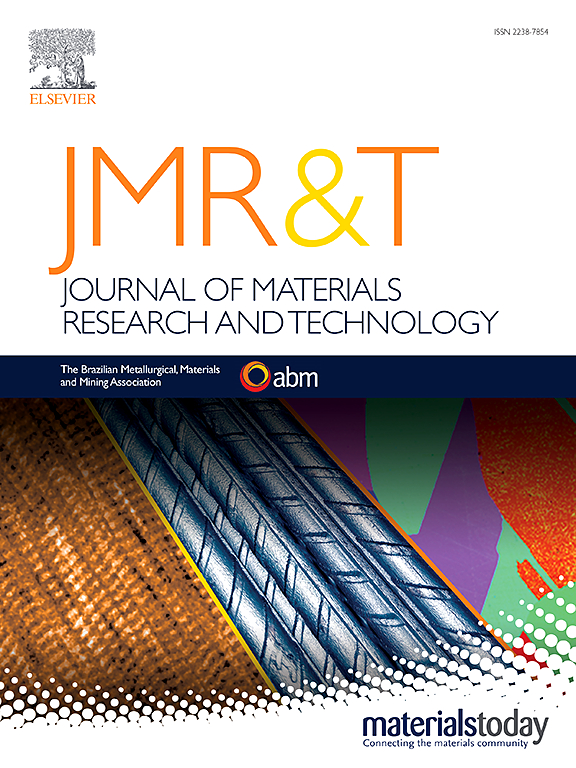Effect of granite waste and steel fibers on the mechanical properties of geopolymer concrete before and after fire exposure
IF 6.6
2区 材料科学
Q1 MATERIALS SCIENCE, MULTIDISCIPLINARY
Journal of Materials Research and Technology-Jmr&t
Pub Date : 2025-06-13
DOI:10.1016/j.jmrt.2025.06.083
引用次数: 0
Abstract
This study investigates the post-fire performance and mechanical properties of geopolymer concrete incorporating granite industry waste as a full replacement for natural fine aggregates, reinforced with steel fibers. High-calcium fly ash was used to produce high-strength concrete cured at room temperature. The results indicated that incorporating granite waste and steel fibers reduced workability due to increased internal friction. The lowest slump flow (37 cm), observed in the mix with 2 % steel fibers, represented a 38 % reduction compared to the control mixture. Despite the reduced workability, the concrete achieved a 28-day compressive strength of 55 MPa and a 45 % increase in flexural strength with 2 % steel fibers. Toughness improved by up to 13 times compared to concrete without fibers. Post-fire testing showed that granite-waste concrete retained mechanical performance comparable to that made with natural sand. After 30 min of fire exposure, the residual compressive strength of concrete without fibers dropped to 39 % of its original value, while flexural strength decreased by approximately 70 %. Incorporating 1 % steel fibers increased toughness by 1.7–2.2 times, whereas 2 % fibers enhanced flexural strength retention by up to 10 % after 60 min of exposure. Microstructural analysis confirmed that steel fibers delayed crack propagation and influenced the thermal transformation of gel phases by increasing the silicon-to-aluminum and calcium-to-silicon ratios. These findings highlight the potential of granite waste and steel fibers as sustainable alternatives to natural aggregates and conventional reinforcement for enhancing both fire resistance and mechanical performance in geopolymer concrete.
花岗岩废料和钢纤维对地聚合物混凝土火灾前后力学性能的影响
本研究研究了用花岗岩工业废料代替天然细骨料的地聚合物混凝土的火灾后性能和机械性能,并用钢纤维进行加固。采用高钙粉煤灰制备室温固化高强混凝土。结果表明,花岗石废料和钢纤维掺入后,由于内摩擦增大,可加工性降低。在含有2%钢纤维的混合物中观察到的最低坍落度(37厘米)与对照混合物相比减少了38%。尽管和易性降低,但混凝土的28天抗压强度达到55mpa,当钢纤维含量为2%时,抗弯强度提高45%。与不含纤维的混凝土相比,韧性提高了13倍。火灾后测试表明,花岗岩-废混凝土的力学性能与天然砂混凝土相当。燃烧30min后,无纤维混凝土的残余抗压强度降至原始值的39%,抗弯强度下降约70%。加入1%的钢纤维可使韧性提高1.7-2.2倍,而在暴露60分钟后,2%的纤维可使抗弯强度保持率提高10%。显微组织分析证实,钢纤维通过提高硅铝比和钙硅比,延缓了裂纹扩展,影响了凝胶相的热转变。这些发现突出了花岗岩废料和钢纤维作为天然骨料和传统钢筋的可持续替代品的潜力,可以提高地聚合物混凝土的耐火性和机械性能。
本文章由计算机程序翻译,如有差异,请以英文原文为准。
求助全文
约1分钟内获得全文
求助全文
来源期刊

Journal of Materials Research and Technology-Jmr&t
Materials Science-Metals and Alloys
CiteScore
8.80
自引率
9.40%
发文量
1877
审稿时长
35 days
期刊介绍:
The Journal of Materials Research and Technology is a publication of ABM - Brazilian Metallurgical, Materials and Mining Association - and publishes four issues per year also with a free version online (www.jmrt.com.br). The journal provides an international medium for the publication of theoretical and experimental studies related to Metallurgy, Materials and Minerals research and technology. Appropriate submissions to the Journal of Materials Research and Technology should include scientific and/or engineering factors which affect processes and products in the Metallurgy, Materials and Mining areas.
 求助内容:
求助内容: 应助结果提醒方式:
应助结果提醒方式:


